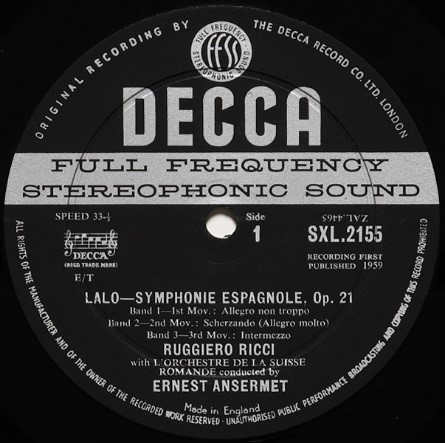Labelographies are available on Classite.com
- Angel Labelography
- Capitol Labelography
- Columbia Labelography
- Decca Labelography
- DGG Labelography
- Ducretet-Thomson Labelography
- EMI Labelography
- Epic Labelography
- Erato Labelography
- Eterna Labelography
- Everest Labelography
- Hungaroton Labelography
- London Labelography
- Lumen Labelography
- Melodiya Labelography
- Mercury Labelography
- Period Labelography
- Philips Labelography
- RCA Labelography
- Remington Labelography
- Supraphon Labelography
- Vanguard Labelography
- Vox Labelography
- Telefunken Labelography
- Westminster Labelography
The Labelography contains (or will eventually contain) examples of labels from all the important companies which have issued microgroove classical records. These label examples span the entire LP era, from the first monaural disks issued in 1949 to the digital and digitally remastered LPs appeared in the early 1980s. The Labelography you find in Classite is an extended format of the Mikrokosmos Labelography. It contains many new Series as mono Philips, Hungaroton, complete Melodiya and the existing series at Mikrokosmos Labelography also expanded (e.g. Erato from 12 labels to 32)
The organization of the Labelography is on three levels: First by record company, then by prefix or series, and finally by a 3-character code.
Record company (1st level)
The user will easily be abler to locate any company desired by the tabs. Please note that companies arranged by the records they produced and not always by name. Thus, US and English Columbia (as distinct companies) are in different locations, but English Columbia, as a part of EMI, is listed under EMI.
Series (2nd level)
Once the desired company has been located, the user will find a summary of each series of records that company has produced. This may be either the actual prefix used by the company itself (e.g. ASD, LSC). The company has been broken down into subgroups only when necessary because of the large number of labels or important series. For some companies (e.g. Eterna, DGG. Duscretet-Thompson), this has not been necessary.
3-Character code (3rd level)
The first digit of this code refers to the country of pressing, the second digit refers to the predominant color of the label and the third digit is a reference number to specify a particular pressing. A listing of the country and color codes follows this foreword. The reference numbers will be, to the best of my ability, in chronological order of issue, so that the lower the number, the earlier the issue. Please remember, however, that for certain companies this chronology is not certain, and for other companies, even where the order is quite certain, that because of the label stocks and other factors, sometimes pressing might have been issued "out of orders". This could happen, for instance, if the Indianapolis plan of RCA ran out of "shaded dog" labels for a given little before one of the other RCA pressing plans did. In other instances, one cannot definitely state which of the two labels is the earlier, as the two labels may have been essentially put into use at the same time. In still other cases, I have not yet been able to obtain information to settle the chronology of the given company's labels.
The one exception to this sorting system is the Melodiya company. For this company, the first letter (character) indicates the various label designs and plants used during the very long tenure of that firm. Many issues under the Melodiya company did not actually use that name of the label (e.g. Accord and Torch labels were used during certain periods). Thus, all the Soviet (Russian) record labels used before and after the Melodiya era are listed here. The second and the third characters for Melodiya are the same as for the other labels.
Please note that the 3-character code does not define a particular label in and of itself. Within a company and series, however, each 3-character code should identify a unique label type.
For instance
...if you would like to describe this

...conversely, if you see Classite offering Decca SXL 2155 with ED1 pressing, you can easily find the exact label being offered by locating the record under Decca, SXL series and then ED1. This system will eliminate the necessity for cumbersome descriptions such as " wide band, grooved, earliest label, English pressing".
Somehow widespread use ED1 as the abbreviation of the first pressing of a record, independently of the country and color. It has nothing to do with the Classite Labelography.
Extended format
The publisher intends that there will be a continual updating and expansion of the Labelography. To this end, we solicit your suggestions to improve our work. This Labelography should be useful for inventorying your own collection or if you offer records for sale. We keep the codes from Mikrokosmos Labelography, so if your collection have been catalogued using this previous editions codes it is valid for the Classite Labelography as well.